Serving 299 students in grades Kindergarten-5, Carver Steam Magnet Elementary School ranks in the bottom 50% of all schools in Arkansas for overall test scores (math proficiency is bottom 50%, and reading proficiency is bottom 50%).
The percentage of students achieving proficiency in math is 15-19% (which is lower than the Arkansas state average of 38%). The percentage of students achieving proficiency in reading/language arts is 15-19% (which is lower than the Arkansas state average of 40%).
The student:teacher ratio of 13:1 is equal to the Arkansas state level of 13:1.
Minority enrollment is 94% of the student body (majority Black), which is higher than the Arkansas state average of 42% (majority Black).
Quick Stats (2025)
- School Type: Magnet School
- Grades: Kindergarten-5
- Enrollment: 299 students
- Student:Teacher Ratio: 13:1
- Minority Enrollment: 94%
- Overall Testing Rank: Bottom 50% in AR
- Math Proficiency: 15-19% (Btm 50%)
- Reading Proficiency: 15-19% (Btm 50%)
- Science Proficiency: 15-19% (Btm 50%)
- Source: National Center for Education Statistics (NCES), AR Dept. of Education
School Overview
Carver Steam Magnet Elementary School's student population of 299 students has declined by 27% over five school years.
The teacher population of 23 teachers has declined by 8% over five school years.
School Type
Grades Offered
Grades Kindergarten-5
Total Students
299 students
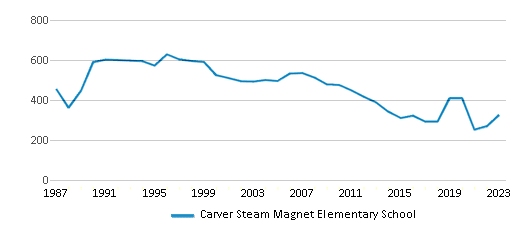
Gender %
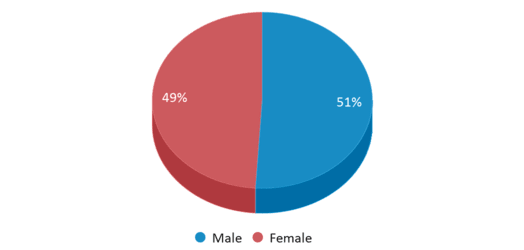
Total Classroom Teachers
23 teachers
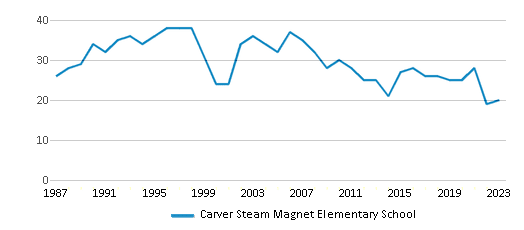
Students by Grade
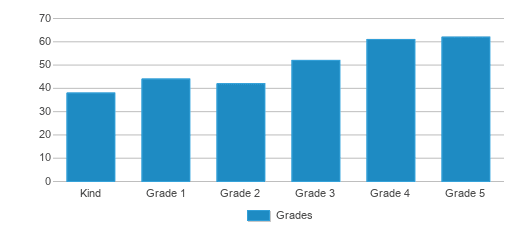
School Rankings
Carver Steam Magnet Elementary School ranks within the bottom 50% of all 997 schools in Arkansas (based off of combined math and reading proficiency testing data).
The diversity score of Carver Steam Magnet Elementary School is 0.27, which is less than the diversity score at state average of 0.61. The school's diversity has stayed relatively flat over five school years.
Overall Testing Rank
#887 out of 997 schools
(Bottom 50%)
(Bottom 50%)
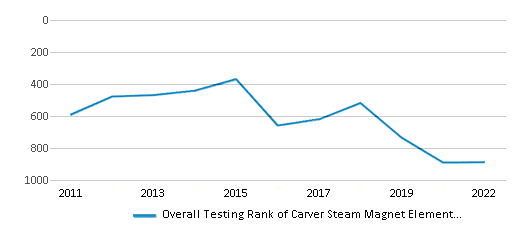
Math Test Scores (% Proficient)
15-19%
38%
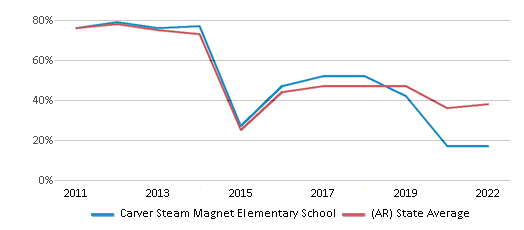
Reading/Language Arts Test Scores (% Proficient)
15-19%
40%
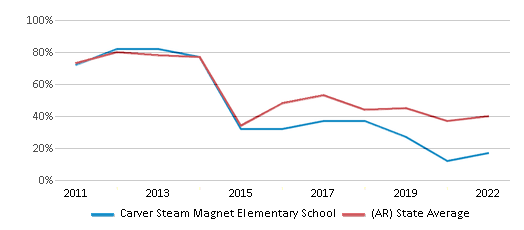
Science Test Scores (% Proficient)
15-19%
36%
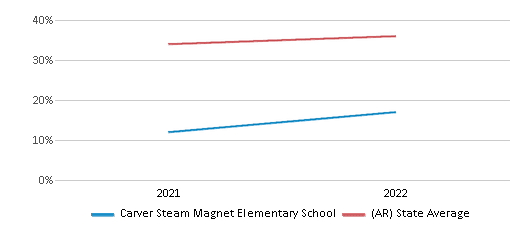
Student : Teacher Ratio
13:1
13:1

American Indian
n/a
n/a
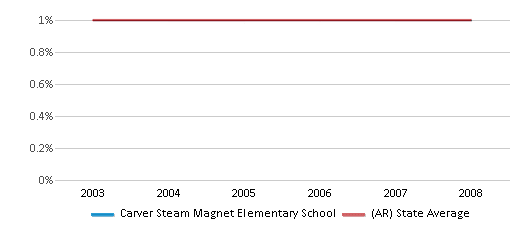
Asian
n/a
2%
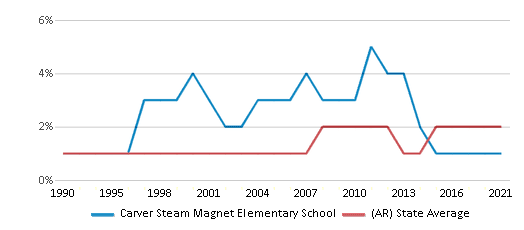
Hispanic
8%
15%
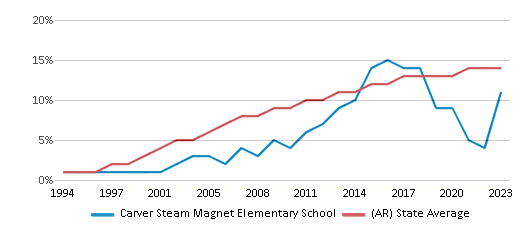
Black
85%
19%
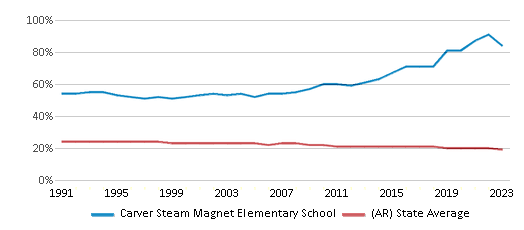
White
6%
58%
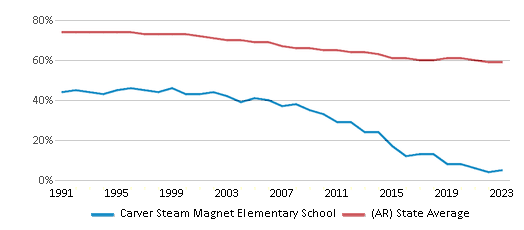
Hawaiian
n/a
1%
Two or more races
1%
5%
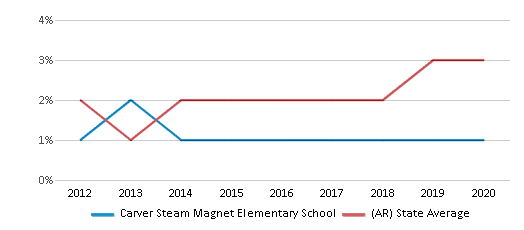
All Ethnic Groups
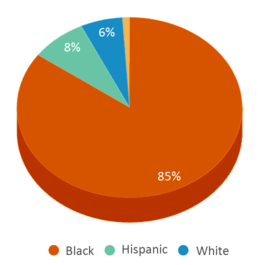
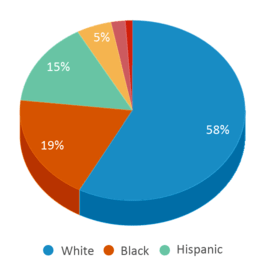
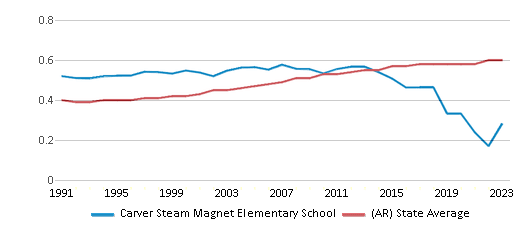
Participates in the National School Lunch Program (NSLP)
Yes
Eligible for Free Lunch
71%
56%
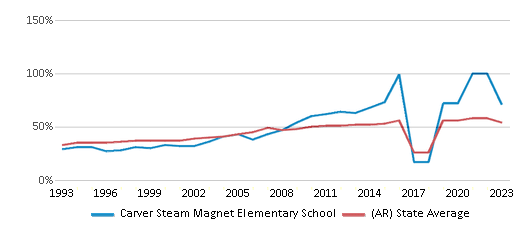
Eligible for Reduced Lunch
18%
10%
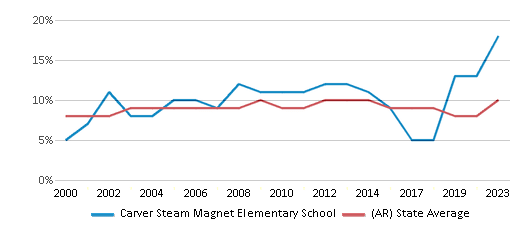
School Statewide Testing
School District Name
Source: National Center for Education Statistics (NCES), AR Dept. of Education
Profile last updated: 02/09/2025
Frequently Asked Questions
What is Carver Steam Magnet Elementary School's ranking?
Carver Steam Magnet Elementary School is ranked #887 out of 997 schools, which ranks it among the bottom 50% of public schools in Arkansas.
What schools are Carver Steam Magnet Elementary School often compared to?
Carver Steam Magnet Elementary Schoolis often viewed alongside schools like Booker Arts Magnet Elementary School, Gibbs Magnet Elementary School, Williams Magnet Elem. School by visitors of our site.
What percent of students have achieved state testing proficiency in math and reading?
15-19% of students have achieved math proficiency (compared to the 38% AR state average), while 15-19% of students have achieved reading proficiency (compared to the 40% AR state average).
How many students attend Carver Steam Magnet Elementary School?
299 students attend Carver Steam Magnet Elementary School.
What is the racial composition of the student body?
85% of Carver Steam Magnet Elementary School students are Black, 8% of students are Hispanic, 6% of students are White, and 1% of students are Two or more races.
What is the student:teacher ratio of Carver Steam Magnet Elementary School?
Carver Steam Magnet Elementary School has a student ration of 13:1, which is equal to the Arkansas state average of 13:1.
What grades does Carver Steam Magnet Elementary School offer ?
Carver Steam Magnet Elementary School offers enrollment in grades Kindergarten-5
What school district is Carver Steam Magnet Elementary School part of?
Carver Steam Magnet Elementary School is part of Little Rock School District.
School Reviews
4 12/26/2017
My school is the best . My story is that I come from Wakefield Elementry and my dad wanted to move me to a magnet we tried Carver and if it wasnt good I would go back to Wakefeild but had nice teacher Ms.Lyneete Hall who was my 4th grade teacher taught me a lot like typing , My 5th grade teacher Mrs .Joy Thomas always teachig me about what should be done so if your tring to find a nice school this is it !
5 9/12/2012
my grandson is starting his 5th year. i love this school, the staff and teachers
really care about the students. we have been very pleased with his school experience. i would highly recommend to anyone looking for a great school!
Review Carver Steam Magnet Elementary School. Reviews should be a few sentences in length. Please include any comments on:
- Quality of academic programs, teachers, and facilities
- Availability of music, art, sports and other extracurricular activities
Recent Articles

What Is A Charter School?
Explore the world of charter schools in this comprehensive guide. Learn about their history, how they operate, and the pros and cons of this educational innovation. Discover key facts about charter schools, including admission policies, demographics, and funding, as well as what to look for when considering a charter school for your child.

10 Reasons Why High School Sports Benefit Students
Discover the 10 compelling reasons why high school sports are beneficial for students. This comprehensive article explores how athletics enhance academic performance, foster personal growth, and develop crucial life skills. From improved fitness and time management to leadership development and community representation, learn why participating in high school sports can be a game-changer for students' overall success and well-being.

February 05, 2025
Understanding the U.S. Department of Education: Structure, Impact, and EvolutionWe explore how the Department of Education shapes American education, from its cabinet-level leadership to its impact on millions of students, written for general audiences seeking clarity on this vital institution.









